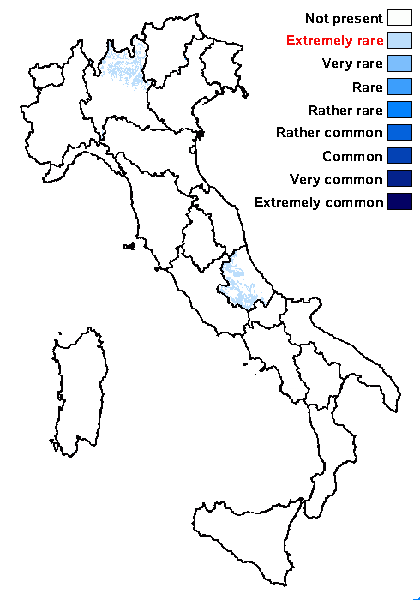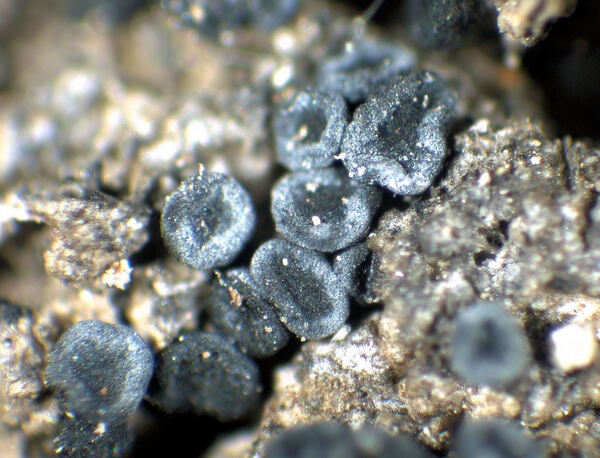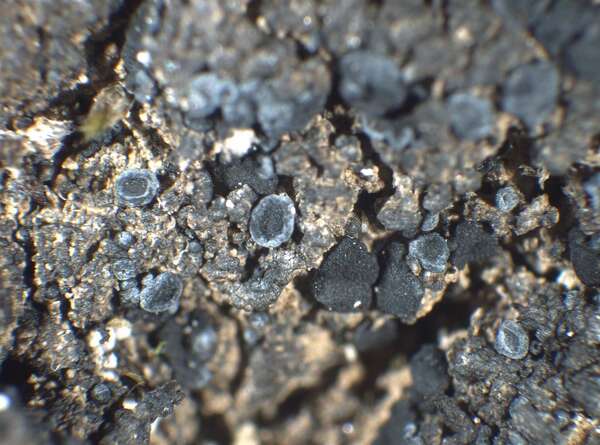Toniniopsis coelestina (Anzi) Kistenich, Timdal, Bendiksby & S. Ekman
Taxon, 67, 898, 2018.. Basionym: Bacidia coelestina Anzi - Atti Soc. Ital. Sc. Nat. Milano, 9: 251, 1866.
Synonyms: Bacidia atrosanguinea subsp. oribata (Nyl.) A.L. Sm.; Lecidea oribata Nyl.; Lecidea subincompta subsp. oribata (Nyl.) Cromb.; Toninia aggregata Vězda; Toninia coelestina (Anzi) Vězda; Toninia oribata (Nyl.) P. James
Distribution: N - Lomb. C - Abr (Gheza & al. 2021).
Description: Thallus squamulose to subcrustose, greyish brown, dull, epruinose. Squamules contiguous, mostly in the form of densely proliferating granules forming a thick, verrucose, more or less continuous crust. Upper cortex almost absent or limited to an up to a 20 µm thick epinecral layer, without crystals; medulla poorly developed, without crystals. Apothecia frequent, lecideine, sessile, strongly constricted at base, up to 1.6 mm across, with a black, often bluish-pruinose, flat to weakly convex, smooth disc, and a distinct, smooth, often pruinose proper margin. Proper exciple dark brown within, with a greenish-black rim reacting K-, N+ violet, lacking crystals; epithecium dark olivaceous green, K-, N+ violet; hymenium colourless, 60-70 µm high; paraphyses not coherent, distinctly thickened in upper part; hypothecium dark brown. Asci 8-spored, clavate, surrounded by a gelatinous I+ blue coat, with a well-developed I+ blue tholus, an I+ darker blue tube and a well-developed ocular chamber, Bacidia-type. Ascospores (3-)7-septate, hyaline, acicular, 19-40 x 2.5-3.5 µm. Photobiont chlorococcoid. Spot tests: thallus and medulla K-, C-, KC-, P-, UV-. Chemistry: thallus without lichen substances. Note: a rare species found on cyanobacterial lichens or cyanobacterial colonies developing on weathered calciferous schists in upland areas.
Growth form: Crustose
Substrata: rocks
Photobiont: green algae other than Trentepohlia
Reproductive strategy: mainly sexual
On otherwise dry surfaces with short periods of water seepage after rain
Commonnes-rarity: (info)
Alpine belt: absent
Subalpine belt: extremely rare
Oromediterranean belt: absent
Montane belt: extremely rare
Submediterranean belt: absent
Padanian area: absent
Humid submediterranean belt: absent
Humid mediterranean belt: absent
Dry mediterranean belt: absent

Predictive model
Growth form: Crustose
Substrata: rocks
Photobiont: green algae other than Trentepohlia
Reproductive strategy: mainly sexual
On otherwise dry surfaces with short periods of water seepage after rain
Commonnes-rarity: (info)
Alpine belt: absent
Subalpine belt: extremely rare
Oromediterranean belt: absent
Montane belt: extremely rare
Submediterranean belt: absent
Padanian area: absent
Humid submediterranean belt: absent
Humid mediterranean belt: absent
Dry mediterranean belt: absent

Predictive model
 Index Fungorum
Index Fungorum
 GBIF
GBIF




